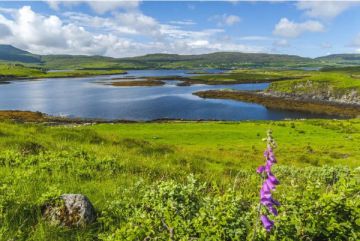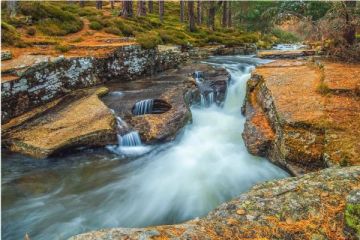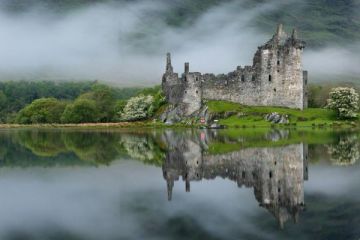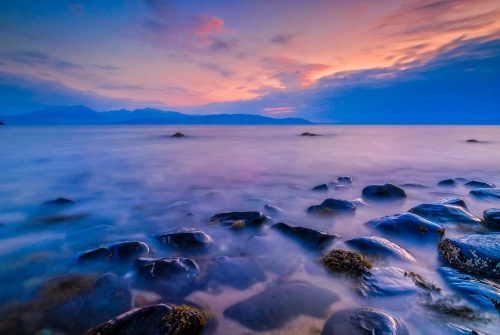
Bute is an island in the Firth of Clyde, north of Arran, and like Arran, it gained popularity in the Victorian period as a resort destination for seaside holidays, particularly for holidaymakers from Glasgow.
Rothesay, the largest town on Bute, still has a Victorian ambience, especially near the Esplanade and Winter Gardens that evolved to serve the influx of 19th-century visitors.
At just 15 miles long and 4 miles wide, Bute is smaller in population and in size than its southern neighbour, Arran, and is home to just over 6,000 people (2011 census).
The Highland Boundary Fault runs through the island, dividing it into highland and Lowland regions. A plaque on the Esplanade in Rothesay marks the line of the Fault, and visitors can stand with one foot on each side of the divide.

All the largest population centres, including Rothesay, are on the east coast, while the west coast is relatively secluded and consists mainly of scattered farms and wide, sandy beaches that were popular destinations for Victorian visitors. One remarkable reminder of those heady days of Victorian visitors is Rothesay's Victorian Toilets, near the pier. The gentlemens' toilets are a testament to luxurious Victorian design, with marble fittings and tile mosaic floors.
Two ferries link Bute to the Scottish mainland. The most widely used by far is the route between Wemyss Bay and Rothesay. Further north, near the tip of the island, a much shorter ferry route links Rhubodach with Colintraive on the Cowal peninsula.

History
Bute abounds in prehistoric sites, with several ancient burial mounds and standing stones, particularly on the west coast of the island. Perhaps the most impressive of these early sites is Dunagoil Hill Fort, a vitrified Iron Age fort on the edge of Dunagoil Bay, in the southwestern corner of the island. Finds from the hillfort are on display at the Bute Museum in Rothesay.
Near Kilmichael, at the northeastern tip of the island, is a late-Neolithic burial mound known as St Michael's Grave. A stone's throw away is a 5th-century Christian chapel with views across the Sound of Bute to Cowal.
By far the most interesting early Christian site, however, is St Blane's Church, near Kilchattan Bay, an early medieval chapel and holy well on the site of a Celtic monastery established by St Blane, a native of Bute and the nephew of St Cattan, who brought Christianity to the island in AD 539. A third ruined chapel stands on a spit of land bordering Scalpsie Bay.

Bute formed part of the Gaelic kingdom of Dal Riata until it was taken by the Norse, but in the 12th century, King David of Scotland granted Bute to Somerled, the king of Kintyre and the Isles. It later passed to the Stewart family, who were granted lordship by Alexander III when the Norse were finally ousted following the Battle of Largs in 1263.
Bute was a major centre for military training exercises during WWII, and you can still see the rotting remains of timber defences in the sand at Scalpsie Bay.
Scalpsie Bay is also home to a large seal colony, and seals can often be seen basking in the sun on rocks at the northern end of the bay.

What to see
The two major historic attractions on Bute are Rothesay Castle and Mount Stuart House (sometimes incorrectly spelled Mount Stewart).
It is hard to imagine two more dissimilar sites!
Rothesay Castle is one of the best-preserved medieval castles in Scotland. It began as a timber fortress erected by the Norse overlord of Bute, and was later transformed into an almost perfectly circular stone castle by Walter Steward (aka Stewart) the High Steward of Scotland.
Steward died in a Norse siege, one of several sieges the castle had to withstand over the centuries. It was taken on multiple occasions by the English, only for the Scots to recapture it again. Perhaps the worst damage, though, was caused by the Earl of Argyll and his Covenanter soldiers in 1685.
The castle was restored by the wealthy 3rd Marquess of Bute and is now in state care.
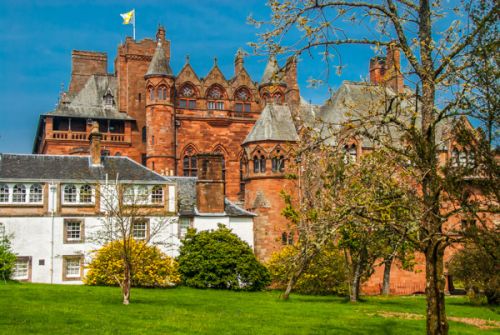
The 3rd Marquess of Bute was also responsible for the other of Bute's major tourist attractions, Mount Stewart. The Marquess wanted a house that expressed his recent conversion to the Catholic faith, and the result is exquisite. Mount Stewart is one of the finest Victorian Gothic buildings in Britain.
The house combines Venetian style with Gothic ideals, creating a very Victorian vision in red sandstone, decorated with a collection of historic paintings, including works by Ramsay, Reynolds, and Gainsborough. The centrepiece room is the Marble Hall, which rises 80 feet to a domed ceiling painted with astrological designs. The effect is simply stunning.
Gardens
The Victorian heritage of Bute lives on in a pair of 19th-century gardens, both located a few miles south of Rothesay.
Ascog Hall Garden and Fernery is a 3-acre garden surrounding a 19th-century house. The garden centres on a sunken fernery that holds a King Fern thought to be the oldest exotic fern in Britain. Ascog Garden is lushly planted with exotic species brought back by Victorian plant hunters, including specimen trees, rare shrubs, and a wide variety of herbaceous perennials.
Just a mile away is Ardencraig Gardens, a lush 19th-century walled garden designed by Percy Cane for the owners of Ardencraig House. The gardens include a mix of bedding plants, with a focus on vividly coloured fuchsias. The garden is laid out around large glasshouses where delicate and exotic plants flourish. There is also an aviary housing species of exotic birds.

Port Bannatyne
North of Rothesay is Port Bannatyne, developed in 1801 as a rival to Rothesay by Lord Bannatyne of Kames Castle. Like Rothesay, Port Bannatyne became a popular destination for tourists from Glasgow in the Victorian period, with a busy hydropathic hotel.
The Kames Hydro Hotel was transformed into a WWII command centre known as HMS Varbel, where the daring operation that sank the German battleship Tirpitz was planned. The focal point of Port Bannatyne is its busy marina, while just inland is Kames Castle, a 16th-century tower house in grounds that include an 18th-century walled garden.
West Island Way
One of Bute's most recent visitor attractions is the West Island Way long-distance footpath, which is laid out in a figure-eight design, with circular loops at the north and south ends of the island linked by a single central section. The trail takes in spectacular coastal scenery and can easily be split up into several days of enjoyable walks.
Getting There
Rothesay is reached by a direct ferry service from Wemyss Bay (postcode PA18 6AR) on the mainland. The ferry takes roughly 35 minutes. There is also a ferry from Colintraeve (postcode PA22 3AP0 to Rhubodach, in the northeastern corner of the island, about 13km north of Rothesay, which takes 5 minutes. As of this writing, you do not need to pre-book ferry tickets; just show up on the day.
More Photos








